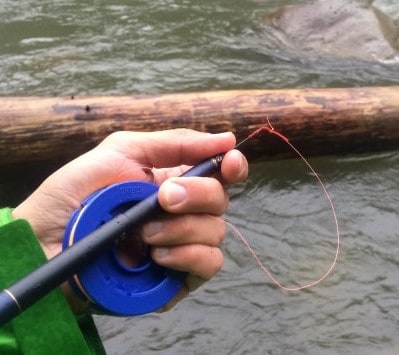"Give a man a fish and you feed him for a day. Teach a man to fish and you feed him for a lifetime." - Chinese proverb OR, "Tell a man where to fish and you give him a place for leisure. Teach a man how to find fishing and you give him a world of fishing, and adventures for a lifetime." - Tenkara USA :) It is common for fishermen to feel protective of their favorite streams, and it can be frustrating for people new to an area, or new to the sport, to know where they can find good fishing. Given that there are so many thousands of streams in the US and in the world, we figured we couldn't even try to give you stream locations. We will not attempt to. But, with our experience in finding our own streams, and often fishing them completely alone, we can give you some advice on how to find waters to fish. And, the best thing about tenkara fly fishing is that tenkara will mostly make you seek scenic small streams that are often much less crowded than any of the big known rivers. There may be many ways to do so, but here are our three favorite methods on finding areas for fishing:
1) Study maps and go for a hike: This is our personal favorite. It allows us to explore, and allows us to feel like we are pioneers. It is relatively easy, and if you can let go of worries it's very rewarding. Maps provide anglers with tons of information. To let go of worries we suggest that you follow some basic guidelines: have enough gas in your tank, have enough food and water with you, make sure you and/or your vehicle are in good condition. Now, to find places on a map, we suggest you look for the clusters of blue veins indicating water in your map. Then, focus on the clusters found in higher elevation - topo maps are particularly useful for this. Then, just go there.
2) Read your state's regulations: The state's regulations books are something an angler may not pay attention to until he is going fishing in a specific stream. But, a regulation book pretty much tells you almost all the streams you may want to fish. It will often tell you what species you can find in the stream, and the regulations of course. They will list major rivers and streams, and often break the streams into pieces based on landmarks. What we often do is search through a book for counties near where we are willing to drive to (most regulations books are available as pdf files in your state's fish and game site, you may scroll down through the pages, or do ctrl+f and type the names of counties you suspect there are mountain streams and are close enough to you that you can drive there). Use these guides alongside with maps to determine streams that may have the elevation you feel is appropriate, will provide adequate gradients of the terrain surrounding the stream (Google maps, especially in terrain mode, Google Earth and the USGS map database are our favorites) and seem to have access points (e.g. no private property markings, trailheads, roads nearby, etc).
3) Connect with anglers via online forums or fishing clubs: You may establish great relationships via online forums, and more so if you have a fishing club near you. Once you start knowing people, sharing your streams and experiences and talking more to them, you'll be a recipient of great secret locations. It's a give and take situation, be expected to share your streams too. One thing to remember is that your stream will not likely become crowded suddenly because you told a few people about it. In fact, the most streams people know about, the more anglers are likely to spread over several places instead of concentrating on the usual and obvious ones. Our take on it is that if we share a location that is several hours away and requires some hiking, most anglers won't be going there everyday. They will go once in a while. Plus, if this angler is willing to explore the stream we suggested, then he is also likely to be exploring other streams. And, finally, if he/she is willing to go there, then it is well deserved that they experience that water.
A last tip: - Know the type of water you like. Do you like small and fast streams with pools, rocks covered in moss, and rocky terrain? If so look for locations on topo maps where the lines may be closer together, which indicates a steeper terrain, but not super close that access is impossible. Or, do you prefer meadow streams, where the view is open and the streams zig-zag through grass and flowers? If meadow streams are your preference make sure the topo map shows lines that are further apart that can indicate less steep gradients and meadows. Knowing the type of water you are looking for will go a long way. Tenkara anglers may really enjoy the faster mountain streams, and knowing that will allow you to look at a map and know where you can go. Plus, your rod and gear will be so light you won't have a problem getting there.
